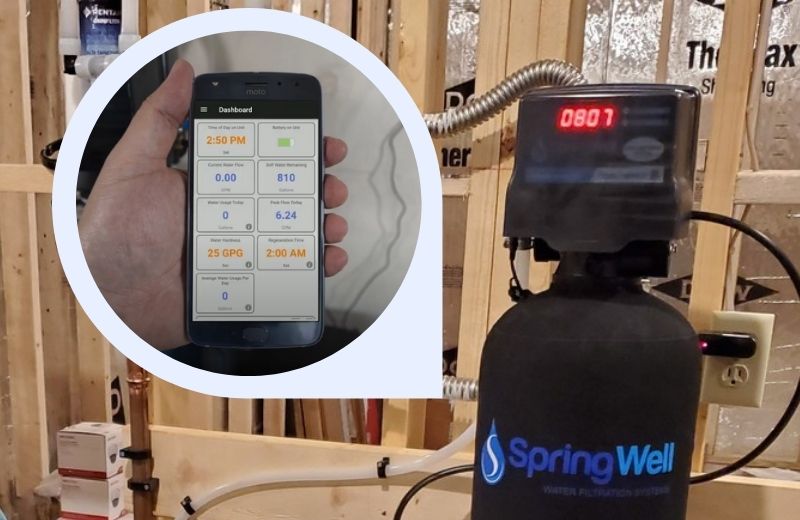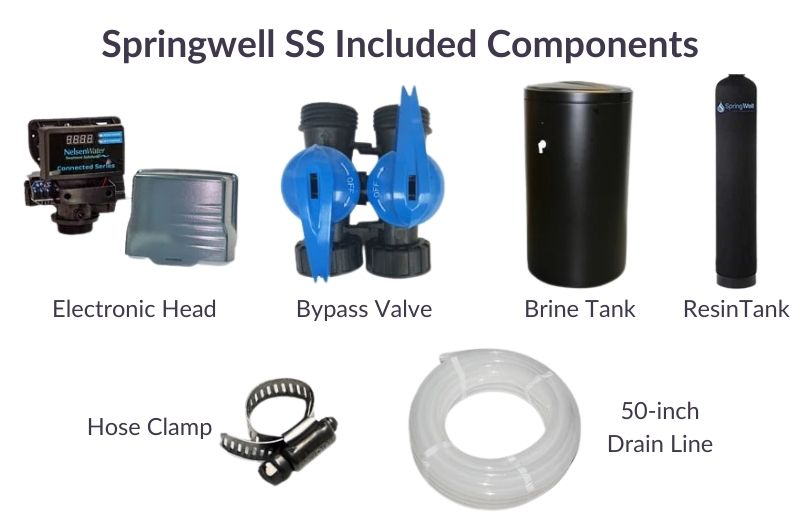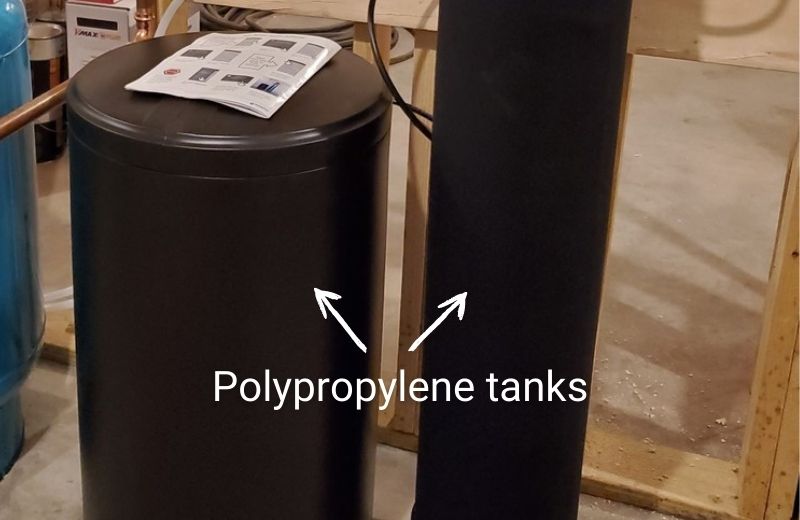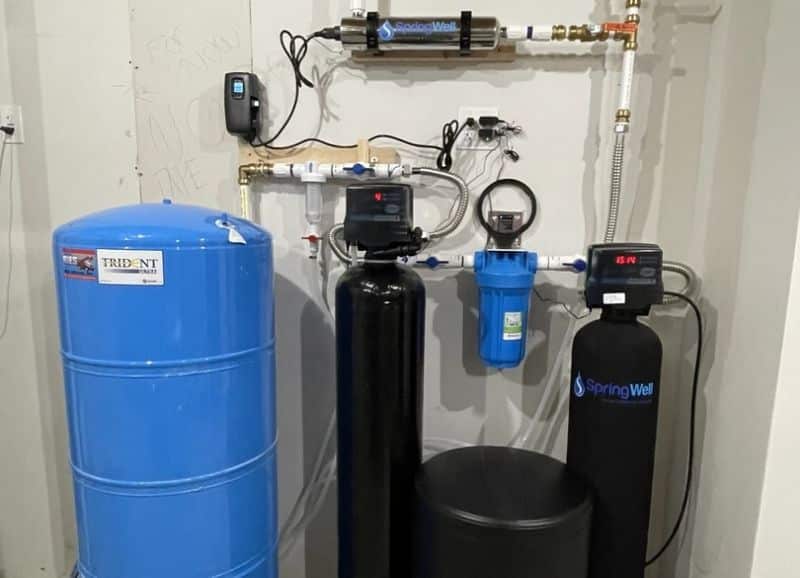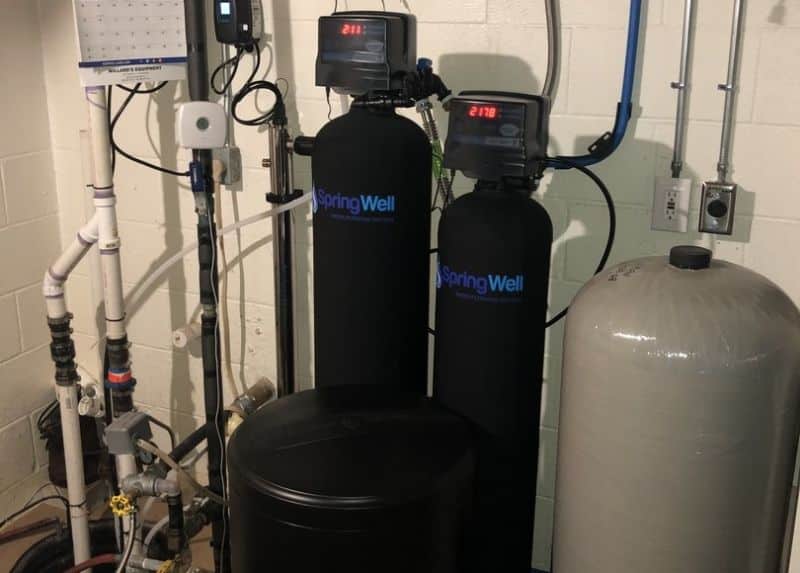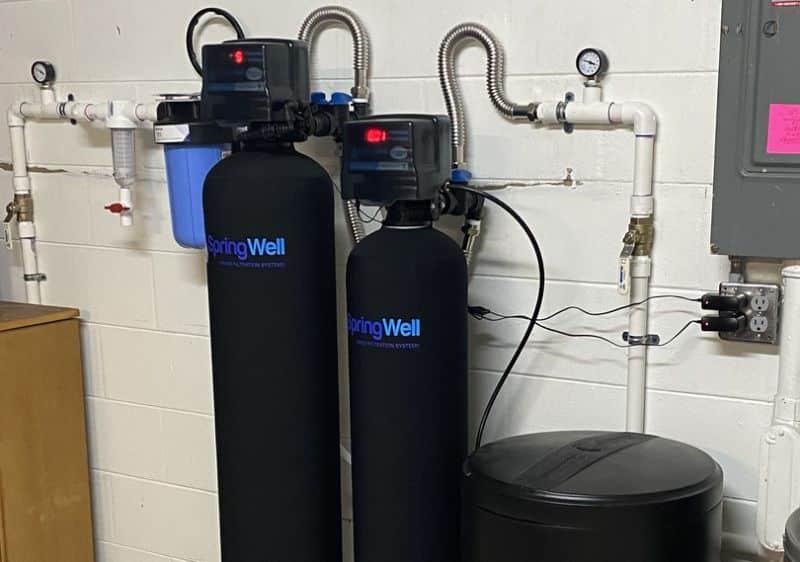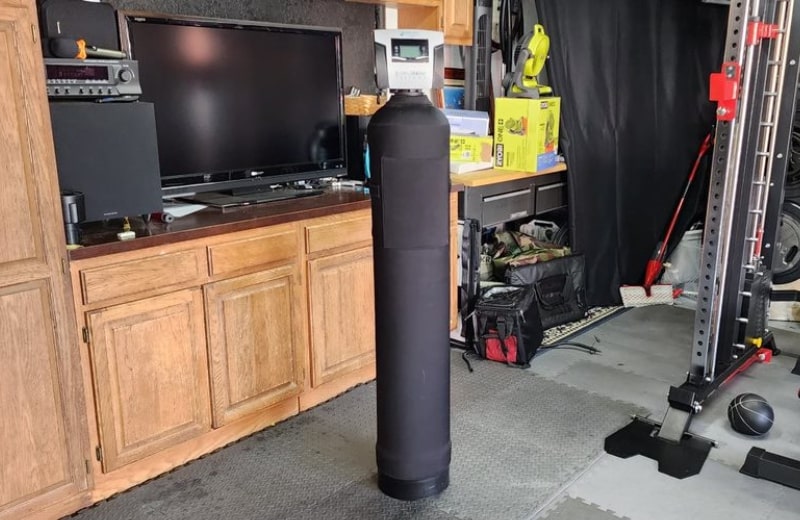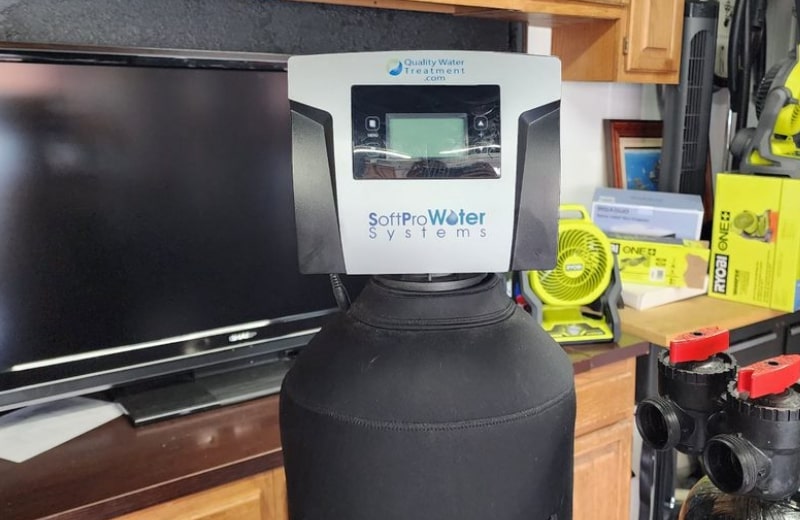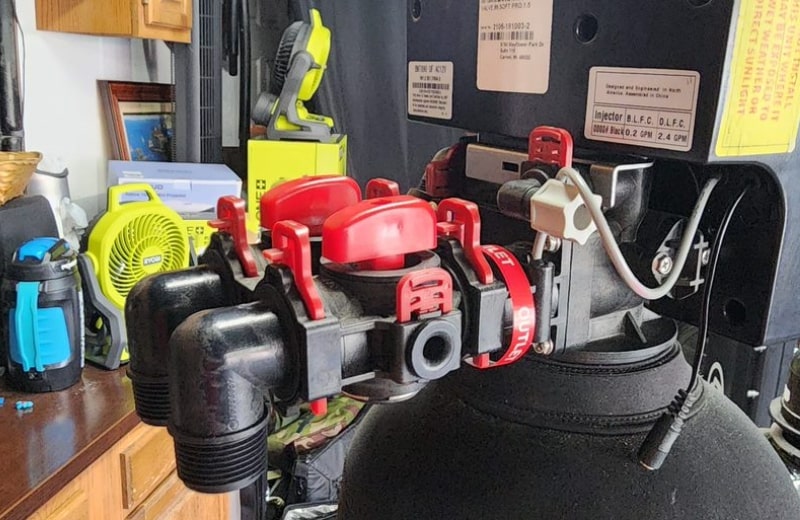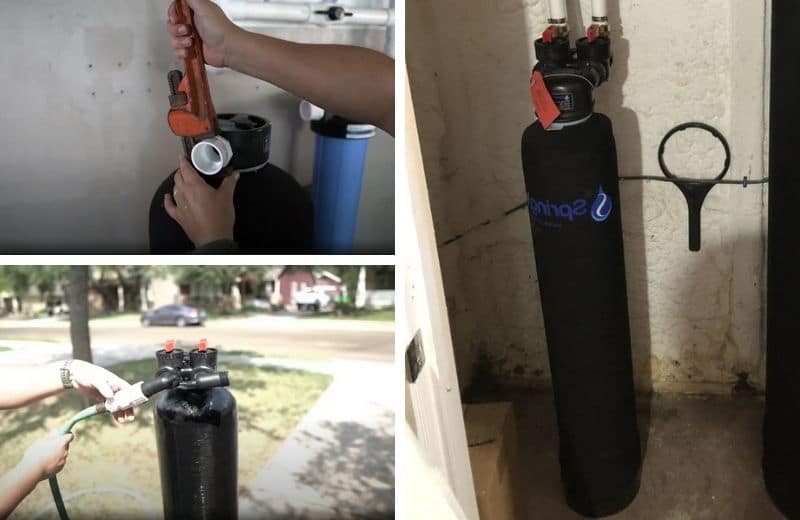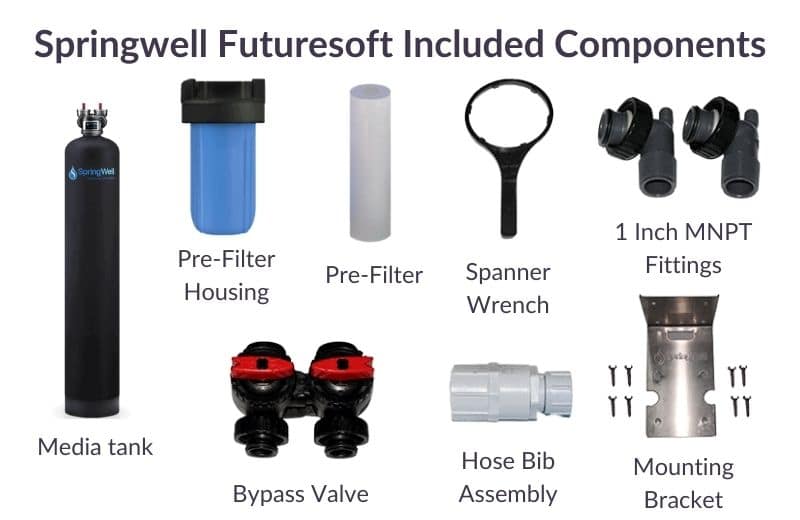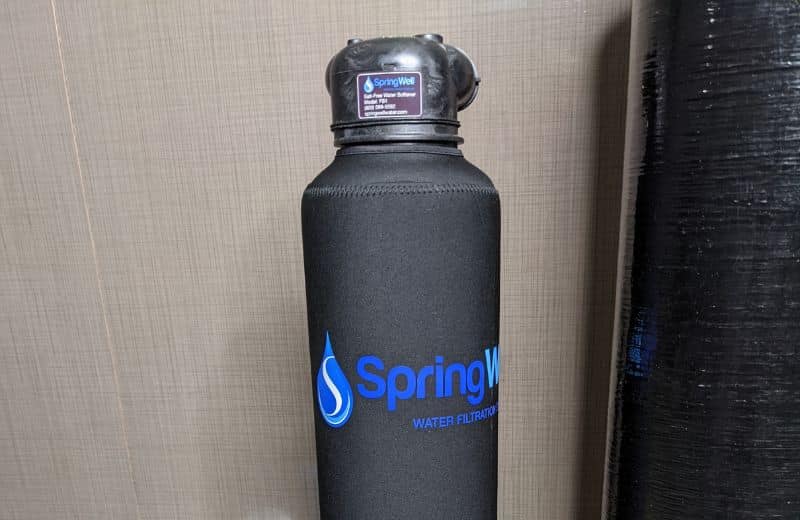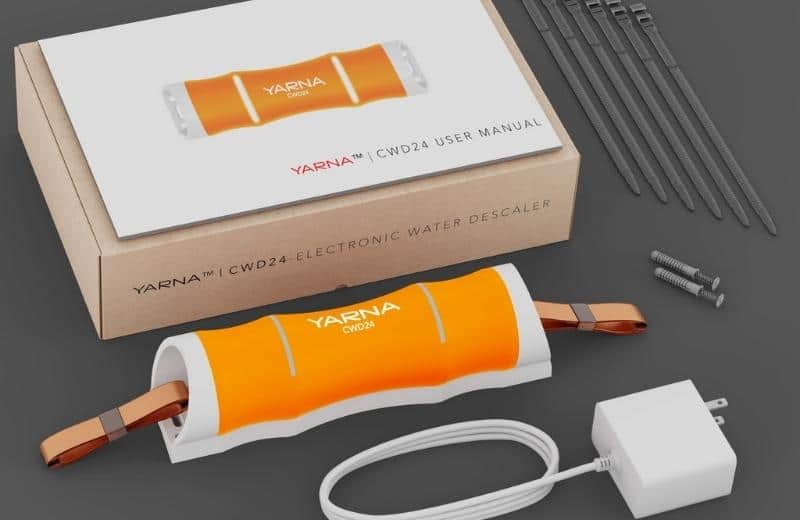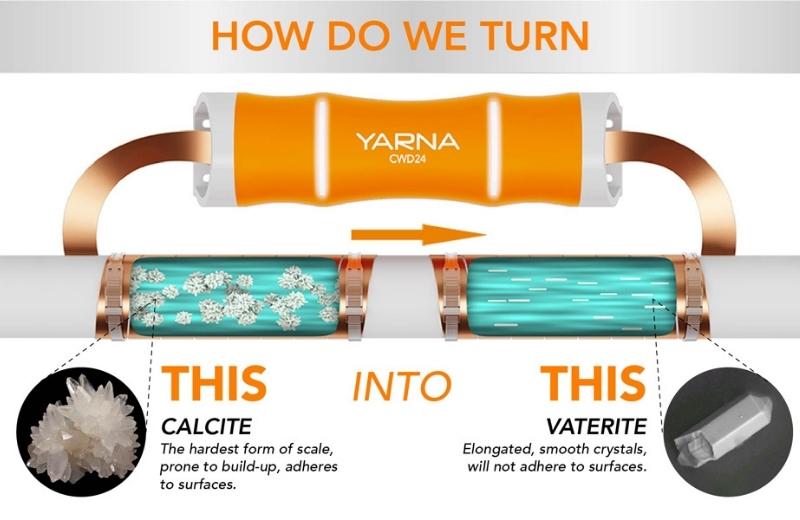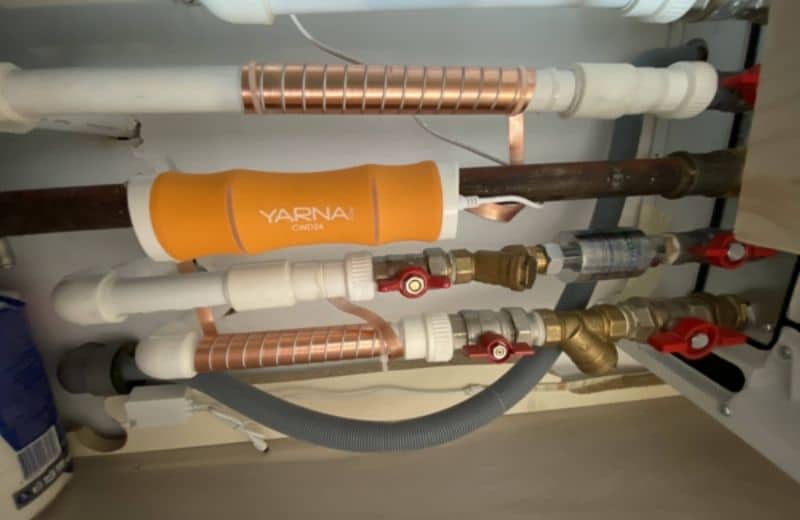These are the best well water softeners, based on technology, efficiency, flow rate, and of course, affordability.
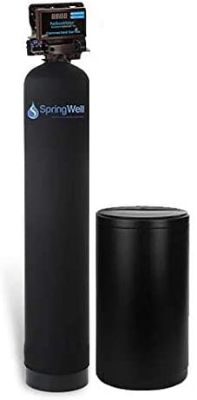
SpringWell SS Salt-Based Water Softener
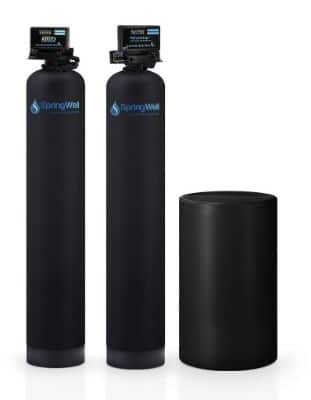
SpringWell WSSS Filter & Softener Combo
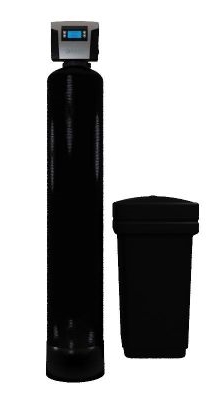
SoftPro Elite Water Softener for Well Water
We’ve been testing and reviewing the most popular water softeners for over a decade. But for this guide, we wanted to focus specifically on water softeners that reliably and effectively treat our well water source, which contains low levels of iron.
It’s not always clear whether or not a water softener can be used with well water. We put dozens of hours into researching and reviewing all the water softeners we could get our hands on, with a particular focus on the features that are important for well water softening.
We ranked the systems on this list based on their hardness and iron reduction potential, capacity options, flow rates, and other essential performance features.
Table of Contents
🥇 Best Water Softeners for Well Water
- Our Top Pick: SpringWell SS Salt Based Water Softener System
- Best for Water with Iron >3 PPM: SpringWell WSSS Filter & Softener Combo
- Budget Pick: SoftPro Elite Water Softener for Well Water
- Best Salt-Free: SpringWell Futuresoft Salt-free Water Softener
- Best for Well Water with Tannins: Springwell Tannin Softener System
- Best Electronic Descaler: Yarna Capacitive Electronic Water Descaler
📊 Comparison of the Best Well Water Softeners
| System | SpringWell SS | SpringWell WSSS | SoftPro Elite | Springwell Futuresoft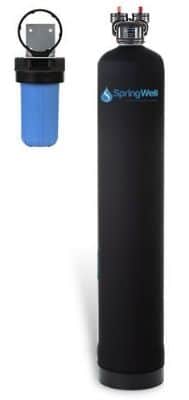 | Springwell Tannin Softener System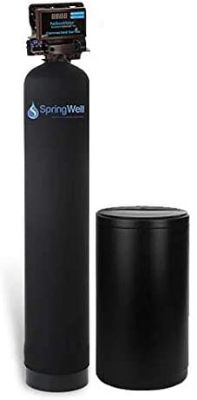 | Yarna Capacitive Electronic Water Descaler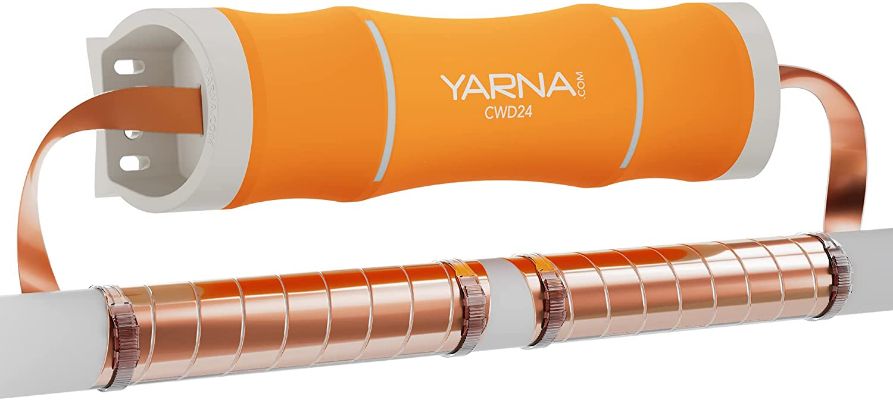 |
|---|---|---|---|---|---|---|
| Ranking | 1st | 2nd | 3rd | 4th | 5th | 6th |
| Ratings | 5/5 | 5/5 | 4.5/5 | 5/5 | 4.5/5 | 4/5 |
| Price | $1530.93+ | $3302.35+ | $1,219+ | $1597.31+ | $2697.86+ | $359.99+ |
| Process | Ion Exchange | Ion Exchange | Ion Exchange | TAC | Ion Exchange | Electronic Descaler |
| Flow Rate | Up to 20 GPM | Up to 20 GPM | Up to 23 GPM | Up to 20 GPM | Up to 15 GPM | n/a |
| Grain Capacity | Up to 80K | Up to 80K | Up to 80K | Up to 81 GPG | 30K or 45K | n/a |
| Max Iron | 3 PPM | 7 PPM | 3 PPM | Requires pre-treatment | 3 PPM | n/a |
🏷️ The Best Water Softeners For Well Water in the News: The Latest Deals and Discounts
In this section, we’ve shared the latest deals and discounts for the water softeners mentioned in our guide. If there’s a sale worth knowing about, we’ve shared it below.
- SpringWell: Save 12% sitewide, deal ends 30
- Softpro: Take extra 15% on all systems, deal ends April 26

SpringWell SS Salt Based Water Softener System
In our opinion, the Springwell SS is the best salt-based water softener for well water available today, and the best water softener for well water. In our testing, it reduced 97.5% of calcium and magnesium hardness ions in our water. It’s also capable of removing up to 3 PPM of iron, so we think it’s a great all-round option that will be a good fit for many well owners.
Specs
| Price | $1530.93+ |
| Process | Ion Exchange |
| Grain Capacity | 32K, 48K, or 80K |
| Water For | Up to 6+ People |
| Flow Rate | Up to 20 GPM |
| Regen Method | Metered |
We used the SpringWell SS to soften a well water supply in the Rocky Mountains near Telluride, Colorado. We had the choice of three softeners in the SS series:
| SpringWell SS Configurations | Price |
|---|---|
| SS1: 1-3 Bathrooms | $1530.93 |
| SS4: 4-6 Bathrooms | $1683.59 |
| SS+: 7+ Bathrooms | $2086.32 |
We went for the smallest SS1, which is a bit more expensive than the similar salt-based water softeners we’ve tested, with a starting price of around $1,530. That makes it about $200-$300 costlier than most of its closest competitors. But it’s backed by an unbeatable lifetime warranty and 6-month money-back guarantee
Best For:
Folks who want to prioritize high-quality water softening but also want to reduce their well water’s iron content with the best-value, most capable water softener available today.
What We Like:
- Removed more than 97% of water hardness in our testing
- Also removes up to 3 PPM of iron
- Excellent warranty & guarantee
- Uses durable, certified components
What We Don’t Like:
- Difficult install
- Doesn’t come with a sediment pre-filter
- Expensive
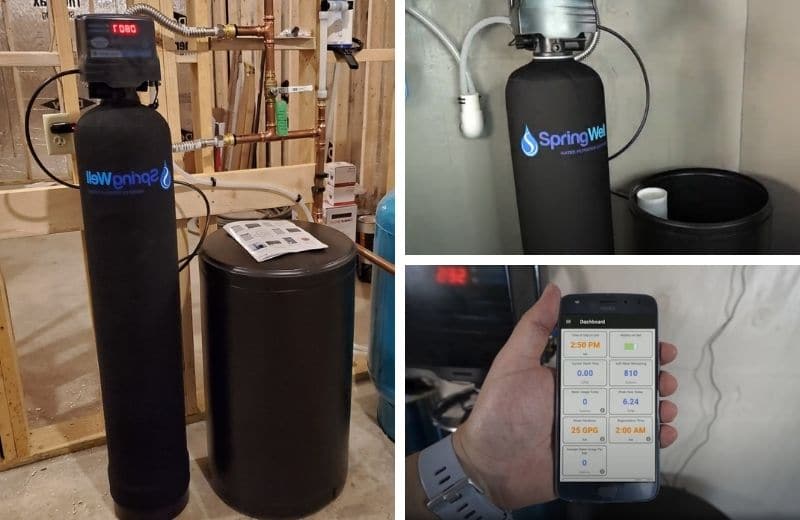
POE Installation & Bluetooth Control
The user manual for the SpringWell SS provides instructions for DIY installation, but we preferred the reassurance of paying to get the unit professionally installed. Our plumber recommended that we upgrade some of the fittings to more durable brass fittings, and they had to contact tech support with a few questions because the installation instructions and images didn’t provide a complete walkthrough.
The system comes with a control head for monitoring and programming the softening and regeneration cycles. We downloaded the Bluetooth app, which meant we could view all the data on our phones, but we know this might be more hassle than it’s worth for some folks.
The starting flow rate for the SS series is 11 GPM, which was plenty for our 2-bathroom household (most homes with well water have a minimum flow rate requirement of 6 GPM).
| Upgrades | Price |
|---|---|
| UV Water Purification System | $1100.99 |
| Reverse Osmosis Water Filter System | $442.23 |
Eliminated 97% Of Hardness Causing Minerals
The SS uses a process called ion exchange – specifically a type of ion exchange called cation exchange – to soften water, which means it exchanges calcium and magnesium hard-causing minerals with sodium (salt) on a charged resin bed.
Ion exchange is the most widely studied and proven method of scale prevention. We found tens of studies in our research, including this 2021 study, which found that 99% of calcium, 69% of magnesium, and 75% of total hardness were removed by a cationic resin.
To find out exactly how well the SpringWell SS worked to soften our water, we conducted two tests: one of our untreated water, and one of our water after it had been softened in the SS system.
The test detected 13.71 grains per gallon, or GPG, of calcium hardness in our well water, which means it’s classed as “hard” according to the USGS). Post-treatment, our water hardness had been reduced by 97.5%, right down to 0.34 GPG, which was an excellent result. There were limitations with our testing, though – our water is hard, but not very hard, so we couldn’t comment on how it would perform with water supplies harder than ours.

The 2.37 PPM of iron in our feed water was also eliminated, but we tested the SpringWell SS alongside the SpringWell AIO system, which specifically targets iron, so we had no way to test the softener’s iron removal abilities alone.

We wanted to test how effectively the SpringWell SS prevented the effects of hard water in our home. To do this, we used a commercial-grade limescale remover to remove scale buildup from our faucets, fixtures, and surfaces. We then monitored these locations over our 6 month testing period. No new limescale formation occurred after installing the SS, proving to us that the system was consistently softening our water throughout our testing period.
View the results of our SpringWell SS laboratory testing in the table below.
| Contaminant | Measurement | Pre-Filtration | Post-Filtration | % Change |
|---|---|---|---|---|
| Total Hardness | PPM | 220.84 | 5.62 | -97.46% |
| Calcium Hardness | PPM | 214.78 | 5.3 | -97.53% |
| Grains per Gallon | Grains | 13.71 | 0.34 | -97.52% |
| Iron | PPM | 2.37 | 0 | -100.00% |
| Manganese | PPM | 0.002 | 0.022 | 1000.00% |
Durable 10% Crosslink Resin
Like all ion exchange water softeners, the SpringWell SS needs routine salt top-ups, and we found that we needed to top up the salt levels in the brine tank every 4 weeks or so.
We were pleased to see that the SS uses a premium 10% cross-link resin – most of the water softeners we found in our research use 8% crosslink resin, which is poorer-quality and less durable. It was a bit confusing to us that the media supposedly lasts 8 years, though, given than most 10% crosslink resins last 15-20 years.
As for maintenance costs, we noticed that our electricity bill increased slightly, but only by around $10. The softener regenerates around once a week (the exact frequency depends on your water hardness), which added around 400 gallons of water to our water bill.
Read the full review: Springwell SS Review

SpringWell WSSS Filter & Softener Combo
In our own testing, the SpringWell WSSS Filter & Softener Combo proved to be the best solution for well water with an iron content of more than 3 PPM. This unit combines SpringWell’s SS salt-based water softener and Well Water Filter System, offering two benefits in one: complete water softening and the reduction of up to 7 PPM iron (ferrous and ferric), 8 PPM hydrogen sulfide, and 1 PPM manganese.
Specs
| Price | $3302.35+ |
| Process | Ion Exchange |
| Grain Capacity | 32K, 48K, or 80K |
| Water For | Up to 6+ People |
| Flow Rate | Up to 20 GPM |
| Regen Method | Metered |
We tested this SpringWell softener and filter system combo on the same well water supply in the Rocky Mountains, CO. We had three system sizes to choose from:
| SpringWell WSSS Configurations | Price |
|---|---|
| WSSS1: 1-3 Bathrooms | $3302.35 |
| WSSS4: 4-6 Bathrooms | $4416.89 |
Cost-wise, the SpringWell Well Water Filter and Salt Based Water Softener Combo is expensive. The smallest 1-3 bathroom model cost just under $3,200 when we got it to review, which makes sense given that we were essentially getting two separate POU water treatment systems in one. It still worked out as a better deal than if we bought both units separately, which would have cost us around $3,600.
Best For:
Folks with a hard well water supply that’s high in iron, manganese, and sulfur, who want the best-value combined filter and softening system that’s more capable of iron reduction than the average softener.
What We Like:
- Tackles hard water and common well water contaminants in one
- Prevents limescale and iron stains
- Best solution for high iron levels
- Made from certified components
What We Don’t Like:
- Expensive
- Particularly difficult to install

Eliminates Hardness & Iron From Home House Water Supply
Like the SpringWell SS, the SpringWell WSSS is intended for DIY installation. But we outsourced the job to a plumber, and we’re glad we did – installing one POE system is tricky enough, but installing two systems alongside one another is particularly complex.
Not all the parts we needed were included for our specific/unique installation, and our plumber didn’t find the instructions comprehensive enough and had to reach out to customer support with a few questions.
Again, we could download the SpringWell app and use the Bluetooth connection to program and monitor the systems from our phones. This isn’t mandatory and you can manually program the control heads if you prefer.
We worried that installing two systems together might impact our water pressure, but even the smallest combo size offers an 11 GPM flow rate, so we didn’t notice any changes in water output after installing the system.
| Upgrades | Price |
|---|---|
| UV Water Purification System | $1100.99 |
| Reverse Osmosis Water Filter System | $442.23 |
Softened Our Water & Completely Removed Iron
The SpringWell WSSS combines two separate systems:
- The SS water softener, which uses ion exchange to replace magnesium and calcium carbonate with sodium ions
- The WS Well Water Filter, which uses air injection to oxidize and remove iron, manganese, and sulfur
Again, we were able to test the SpringWell WSSS to see how it affected our well water quality.
As mentioned in the SS review, our pre-treated water contained 13.71 GPG of hardness and 2.37 PPM of iron. Post-treatment, our water hardness was reduced by more than 97%, and our water’s iron levels were eliminated entirely.
Our feed water also contained very low levels of manganese (0.002 PPM). The SpringWell WS is supposed to remove manganese, but manganese actually increased slightly to 0.022 PPM in our treated water.

We think this could have been due to leaching from the system’s manganese greensand bed, or possibly due to the soft water and dissolved oxygen stripping built-up manganese from inside our plumbing. We only tested our water once, and there are limitations with this – we’ll need to re-test it to see if manganese is detected post-treatment again.
Other metals that were greatly reduced or removed by the WS included zinc, molybdenum, chromium, selenium, cobalt, vanadium, copper, nickel, barium, strontium, and boron. This was a bonus that we didn’t expect, given that the system is only marketed to remove iron, sulfur, and manganese.


We were pleased with the improvement in our water quality post-filtration. We noticed no new limescale, and the problems we’d previously been experiencing with iron/rust formation went away completely.
In the table below, you’ll find our SpringWell WSSS laboratory testing data.
| Contaminant | Measurement | Pre-Filtration | Post-Filtration | % Change |
|---|---|---|---|---|
| Antimony | PPM | 0.0003 | 0.0005 | 66.67% |
| Barium | PPM | 0.051 | 0.003 | -94.12% |
| Boron | PPM | 0.023 | 0.013 | -43.48% |
| Calcium | PPM | 56 | 1.44 | -97.43% |
| Chloride | PPM | 10.5 | 11.4 | 8.57% |
| Chromium (Total) | PPM | 0.001 | 0 | -100.00% |
| Cobalt | PPM | 0.0007 | 0 | -100.00% |
| Copper | PPM | 0.211 | 0.091 | -56.87% |
| Fluoride | PPM | 0 | 0.244 | n/a |
| Hardness | PPM | 220.84 | 5.62 | -97.46% |
| Iron | PPM | 2.37 | 0 | -100.00% |
| Lithium | PPM | 0.079 | 0.003 | -96.20% |
| Magnesium | PPM | 18.2 | 0.414 | -97.73% |
| Manganese | PPM | 0.002 | 0.022 | 1000.00% |
| Molybdenum | PPM | 0.003 | 0.002 | -33.33% |
| Nickel | PPM | 0.009 | 0.0009 | -90.00% |
| Nitrate (as N) | PPM | 0.309 | 0.364 | 17.80% |
| Potassium | PPM | 1.43 | 0.156 | -89.09% |
| Selenium | PPM | 0.002 | 0.001 | -50.00% |
| Silica | PPM | 9.04 | 12.6 | 39.38% |
| Sodium | PPM | 18.8 | 191 | 915.96% |
| Strontium | PPM | 1.08 | 0.015 | -98.61% |
| Sulfate | PPM | 132 | 151 | 14.39% |
| Titanium | PPM | 0.001 | 0.0005 | -50.00% |
| Turbidity | NTU | 0.42 | 0.21 | -50.00% |
| Uranium | PPM | 0.002 | 0.002 | 0.00% |
| Vanadium | PPM | 0.0007 | 0 | -100.00% |
| Zinc | PPM | 0.126 | 0.074 | -41.27% |
Long-Term Low-Maintenance Solution
We were slightly concerned that installing two systems would mean twice the maintenance, but the WS filter system is essentially maintenance-free.
We just had to empty out the spin-down sediment filter occasionally (that’s right, the WS actually comes with a sediment filter). The manganese greensand media lasts between 18 and 25 years, so we didn’t have to worry about regular maintenance for this system.
As always, we had to top up the water softener salt, and our water bill was slightly higher because we had two systems regenerating/backwashing occasionally.

SoftPro Elite Water Softener for Well Water
We think the SoftPro Elite is the best budget pick well water softener. This salt-based softener has a low upfront cost of just over $1,200 (that’s around $300 cheaper than the SpringWell SS) and is also one of the most efficient salt-based water softeners we’ve reviewed, reducing its ongoing costs.
Specs
| Price | $1,219+ |
| Process | Ion Exchange |
| Grain Capacity | Up to 80K |
| Water For | Up to 6+ People |
| Flow Rate | Up to 23 GPM |
| Regen Method | Metered |
We could buy the SoftPro Elite in 6 different sizes, with grain capacities* ranging from 24,000 to 80,000. The 24,000-grain system should be fine if you’re a smaller household with moderately hard water, but most families of 4 will need to at least upgrade to the 32,000-grain system, which costs an extra $120. So keep in while that the starting cost for the smallest model is lower, the 24,000-grain softener might be undersized for you.
*Grain capacities essentially tell you how many grains the water softener can remove from your water before it needs to regenerate and replenish the sodium ions in the resin. The quick and easy way to work out the correct water softener grains capacity for you is to use a special grains capacity calculator tool.
| SoftPro Elite Configurations | Price |
|---|---|
| 24000 | $1129 |
| 32000 | $1229 |
| 40000 | $1289 |
| 48000 | $1369 |
| 64000 | $1419 |
| 80000 | $1629 |
| 96000 | $2189 |
Best For:
Anyone looking for a more affordable well water softener, who still wants the reliability of ion exchange water softening technology.
What We Like:
- Affordable options for smaller budgets
- Efficient water softening helps save money
- 6 system sizes/grain capacities to choose from
- Backed by a lifetime warranty
What We Don’t Like:
- Tricky installation
- You may need to upgrade to a bigger model
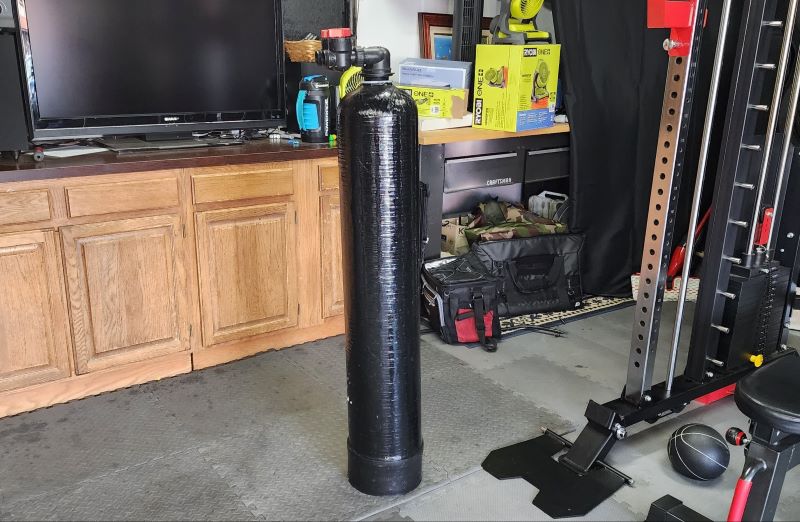
Potential for DIY Installation
The SoftPro Elite user manual is pretty wordy and overwhelming, but it does provide all the information needed to install and properly look after your water softener.
Quality Water Treatment has also shared a video on YouTube that goes through the unboxing and installation process; it’s not the best quality but it’s pretty in-depth.
Do we think you can install this yourself? Yes, if you’re pretty handy – it’ll take around 4 hours, according to the user manual. It’s not something we’d do personally because we prefer the reassurance of a professional installation for POE systems.
The starting flow rate for the SoftPro Elite Well Softener is 6-7 GPM, which is lower than most other base-model softeners we reviewed. The flow rate varies depending on the system size you choose; the largest system has a flow of up to 23 GPM, so you definitely have options for every household here.
Effective, Efficient Water Softening
Some of the cheaper water softeners we found in our research struggle to reliably soften water – in other words, you compromise on performance by going for something more budget-friendly.
But the SoftPro Elite softener met our high standards even while being cheaper than its competitors. It uses ion exchange to soften water by removing calcium and magnesium ions, and up to 3 PPM iron.
Plus, the softener’s unique efficiency features made it a standout from many of the other water softener units we reviewed. These included:
- If the total capacity of the tank ever falls below 3%, the system will undergo a 15-minute recharge to add additional capacity to ensure it can continue to soften water until it’s set to regenerate.
- The Precision Brining feature also saves salt by making only 70% of brine. Before the system performs a regeneration cycle, it calculates exactly how much brine you’ll need to regenerate the resin.
- The system will even perform an automatic refresh if it hasn’t been used for seven days, helping to prevent bacteria growth in the brine tank.
We think these features should help to reduce water and salt waste and maintain good softening conditions, ensuring the operation costs are low. So not only is the SoftPro Elite more affordable upfront, but it might also be more cost-effective to operate in the long term.
Maintenance is pretty standard for a salt-based water softener. The brine tank is wide-mouthed to make salt top-ups less messy. Just keep in mind that this is another system that doesn’t come with a sediment pre-filter, which we recommend using if you want to protect the softening resin.
Read the full review: SoftPro Elite Water Softener Review

SpringWell Futuresoft Salt-free Water Softener
In our opinion, the Springwell Futuresoft Water Softener is the best salt-free well water softener available today. This system offers 99.6% scale prevention (better than any other salt-free softener we’ve reviewed) using the popular TAC (or Template Assisted Crystallization) process to crystallize hard water minerals, preventing them from sticking to surfaces.
Specs
| Price | $1597.31+ |
| Process | TAC |
| Max Hardness | 81 GPG |
| Water For | Up to 6+ People |
| Flow Rate | Up to 20 GPM |
| Regen Method | n/a |
The unit comes in three sizes:
| SpringWell Futuresoft Configurations | Price |
|---|---|
| FS1: 1-3 Bathrooms | $1597.31 |
| FS4: 4-6 Bathrooms | $1960.43 |
| FS+: 7+ Bathrooms | $2657.63 |
The FutureSoft was almost exactly the same price as the SS when we reviewed it, which is pretty decent given that it uses a water conditioning process that requires no salt, so it’s cheaper and easier to maintain. All we had to do was replace the sediment pre-filter every 9 months or so, costing less than $50 a year.
This system is one of the few salt-free conditioners we’ve reviewed that’s up for the task of reducing scale formation in even very hard water, but it won’t make a difference to your water’s iron content, so it’s no good for iron-laced well water unless it’s used with an iron removing pre-filter.
Best For:
People who want to avoid the hassle, taste, and potential health effects of using salt-based water softeners but still want the exceptional scale reduction performance of the best salt-free water conditioner.
What We Like:
- Maintenance-free
- Retains healthy minerals in water
- Doesn’t affect water taste or feel
- Prevents scale formation & removes existing scale
What We Don’t Like:
- Doesn’t make a difference to water’s iron levels
- No way to test to see if it’s actually working
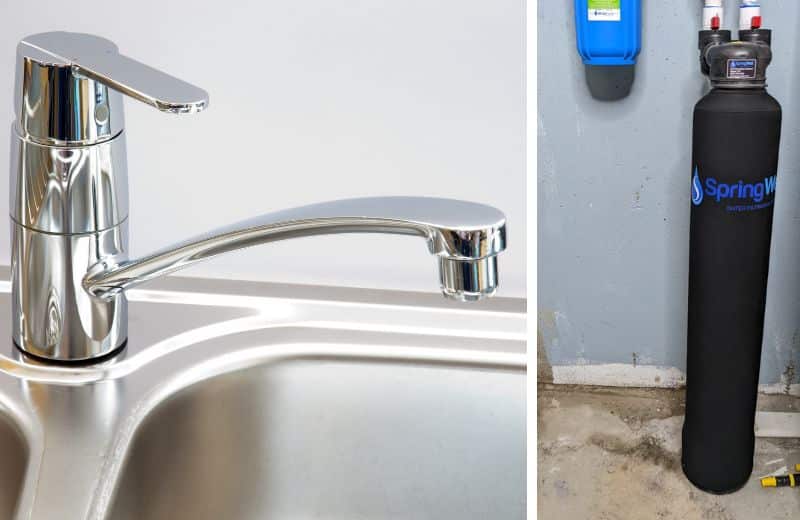
Proven TAC Water Conditioning
Honestly, we’ll normally always go for the conventional salt-based water softeners because they’re the best equipped to deal with very hard water, but we know that some folks just don’t want the salt use and maintenance associated with an ion exchange system. If that’s you, we think the SpringWell FutureSoft is the best salt-free alternative you’ll find.
It uses a process called template-assisted crystallization, or TAC for short, to alter the structure of hard water minerals. In their new crystalized form, the hardness minerals are unable to stick to each other or surfaces and form limescale.
Many of the salt-free softeners we’ve tested can only reduce scale by about 50%, but the FutureSoft can reduce up to 99.6% of limescale formation, making it suitable even for extremely hard water.
It has a decent flow rate, too – the smallest unit has a 12 GPM flow rate, which was more than enough for us. In our testing, it didn’t affect our water pressure or flow rate after we installed it.
What studies have been conducted on TAC water conditioning? This 2018 study concluded that TAC conditioning was the most suitable technology, alongside conventional water softening, for household use. However, it also noted that water post-treatment only formed “somewhat less scale” than untreated water. There’s limited research on TAC technology currently.
Environmentally-Friendly, Reliable Water Conditioning
There were a few reasons why we actually preferred this salt-free system for tackling hardness minerals in our well water.
For a start, it’s environmentally friendly and cost-effective because it doesn’t waste water or use electricity or salt like an ion exchange water softener. It also made no difference to the feel of our water (it didn’t feel slippery as you get with salt softened water) and it didn’t demineralize our water, so we could still enjoy the taste and health benefits of calcium and magnesium.
We know that some folks live in communities where salt-using water softener systems are banned. If that’s the case for you, you can still use a TAC conditioner like the FutureSoft.
Given that the FutureSoft doesn’t actually soften water (it just conditions it), we were keen to test whether it could still do a good job of reducing scale inside our home’s plumbing. The TAC process supposedly prevents buildup inside pipes, fixtures, and heating elements, as well as removing existing scale.
In our own testing, we noticed no new scale formation after installing the FutureSoft. However, we did notice some hard water spotting on surfaces. We could easily wipe this away, though, because it was unable to stick to surfaces as limescale.
May Require Pre-Filtration
Are there any caveats of this system for well water? Yes – as with the other salt-based systems, we think installation might be a bit too much for some folks. Even though the single-tank unit isn’t as complex as a conventional softener, we still hired a plumber to install the system for us, which cost extra.
Plus, common well water contaminants will foul the TAC media, so we needed to use additional pre-treatment to prevent damage by iron and other problematic impurities in our groundwater supply.
Finally, there was no way to know for certain that the system was actually working because we couldn’t do a water hardness test (the minerals are still present post-treatment). That could be a dealbreaker for some folks.
| Upgrades | Price | Uses |
|---|---|---|
| UV Water Purification System | $1100.99 | Boil water advisory protection |
| Whole House Water Filter System | $1016.44 | Whole house water contaminant reduction |
| Reverse Osmosis Water Filter System | $442.23 | Drinking water |
Read the full review: Springwell Futuresoft Review

Springwell Tannin Softener System
We’ve found that the SpringWell Tannin Softener System is the best well water softener for tannin-laced well water. This softener reduces hardness minerals and impurities that give water an unpleasant tea-like appearance, all within a single tank.
Specs
| Price | $2697.86+ |
| Process | Ion Exchange |
| Grain Capacity | 30K or 45K |
| Water For | Up to 6+ People |
| Flow Rate | Up to 15 GPM |
| Regen Method | Metered |
The SpringWell Tannin Softener System is available in two sizes:
| Springwell Tannin Configurations | Price |
|---|---|
| STR 1: 1-3 Bathrooms | $2697.86 |
| STR 4: 4-6 Bathrooms | $2918.18 |
The smallest model costs just under $2,700, making it over $1,000 more expensive than SpringWell’s conventional water softener. So we think this system is only really worth it if you have noticed signs of tannins in your water (a bitter taste, or a yellow or brown tint in the water), and it just makes sense for you to tackle the issue alongside your hard water problem.
Best For:
Folks with big budgets who want the most convenient all-in-one solution for removing tannins and hardness minerals from well water.
What We Like:
- Tackles tannins & water hardness in an all-in-one system
- Minimal maintenance – system regenerates & backflushes regularly
- Eliminates water hardness with ion exchange softening
- Includes a sediment pre-filter to protect the resin
What We Don’t Like:
- Expensive
- A lack of information about tannin removal media
Salt-Based Water Softening + Tannins Removal
What makes the SpringWell Tannin Softener System different from SpringWell’s conventional Salt-Based Water Softener?
The mineral tank, or resin tank, doesn’t only contain water softening resin. It also contains “state of the art media” that targets and removes tannins. There’s no note on exactly what this media is. We reached out to SpringWell’s customer support team to find out more, and the rep we spoke to told us that there’s an anion exchange resin in the tank that removes tannins AS WELL as a cation exchange resin that removes hardness minerals, which is pretty interesting – it’s definitely efficient that both of these processes can take place in the same tank.
We definitely appreciate that the Tannin Softener System can completely remove tannins, so you shouldn’t need to reinforce the system with a separate filter. Plus, the sediment filter will remove larger sediment that may also give your water a dirty appearance.
Design-wise, this is essentially your traditional water softener, with a resin tank (called a tannin removal tank in this setup), a brine tank, and a sediment pre-filter. The same maintenance applies to this system as for any salt-based water softener – the brine tank will need topping up to keep the ion exchange process working smoothly.
As with the other SpringWell systems, the Tannin Removal System is manufactured from certified components. The brine tank and tannin removal tank come with a lifetime warranty and a 6-month money-back guarantee, giving us the peace of mind we needed to spend our money.
Things to Know About Installation & Maintenance
If you’re competent with DIY, you should be able to install the softener yourself using the installation guide or YouTube video. But, as with all the other systems we’ve reviewed here, we would personally recommend paying a bit extra for a professional installation, just for the peace of mind.
From what we can tell, the tannin removal media is backwashed when the softener regenerates, and this should remove the collected contaminants, so you won’t need to replace the media every few months as you would with a filter cartridge.
Something we learned about the long-term costs of this system is that it requires more frequent regenerations to prevent organic fouling of the inner resin beads. That means it’ll be using more water every month, so you’ll notice a slightly bigger increase in your monthly water bill compared to a conventional water softener.
| Upgrades | Price |
|---|---|
| UV Water Purification System | $1100.99 |
| Reverse Osmosis Water Filter System | $442.23 |
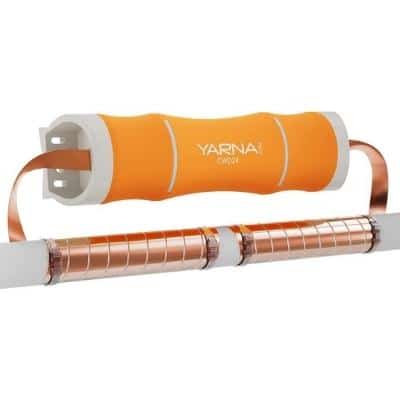
Yarna Capacitive Electronic Water Descaler
We think that the Yarna Capacitive is the best electronic descaler for well water currently on the market. It reduces scale buildup with a changing field of electricity, and costs just $300, making it the cheapest on this list by far. Its unique tankless design requires virtually no installation and no maintenance, and doesn’t waste water or require salt, resin, or media to operate.
Specs
| Price | $359.99+ |
| Process | Electronic Descaler |
| Wattage | 4 |
| Max Hardness | No Max |
| Warranty | 1 year |
The Yarna Capacitive Electronic Water Descaler costs just under $300, so it’s definitely one to consider if you can’t afford, or justify, the cost of a conventional salt-based water softener. No, it’s not going to offer the comprehensive scale prevention of an actual water softener, but the results are still pretty good.
Best For:
Folks with moderately hard water looking for the best affordable well water descaler that’s easy to install and completely maintenance-free.
What We Like:
- Affordable
- No-install setup
- No tanks; space-saving design
- Maintenance-free
What We Don’t Like:
- Not recommended for hard or very hard water
- Can only operate with electricity
Unique Electromagnetic Descaling Process
The Yarna descaler is completely unique from the other salt-free water conditioners we reviewed for well water. It consists of a cable that coils around your main water pipe, which alters the state of hardness minerals by delivering a high-frequency modulated electromagnetic field into the water that flows into your home.
From an installation perspective, this really does have its appeal. For once, we didn’t feel the need to pay for a plumber to handle the install process for us, because the Yarna descaler doesn’t actually intercept your water line. It just gets mounted on a wall and treats water from outside the pipe. Plus, the scale-prevention process doesn’t intercept your water, so it wouldn’t have any impact whatsoever on our whole-home water pressure or flow.
The lack of installation also makes this salt-free system ideal for folks who rent, and are unable to make permanent changes in their home. It can be installed on any pipe up to 1 inch thick (including pipes made of copper, iron, stainless steel, plastic, or PVC) and can be used effectively in homes of any size – the manufacturer has tested it and found it effective for 1.2 miles beyond the install location.
Even better, the Yarna Capacitive is completely maintenance-free. We wouldn’t have to top up the salt or set a control valve – and there isn’t even any media that will eventually need changing. That means it’s the most affordable and low-maintenance well water softener we reviewed in terms of long-term operation.
Effective For Moderately Hard Well Water
What do we personally think about electromagnetic descaling for well water?
It is a legitimate technology, as proven by several studies (this WaterReuse Research study found that it could reduce 17%-70% of limescale). Still, because this technology isn’t as powerful or effective as ion exchange water softening or even TAC water conditioning, we only recommend it for folks with moderately hard well water supplies.
There’s also the same issue that we had with the SpringWell FutureSoft: we couldn’t prove with a before-and-after water test that the system was actually working, because the hardness minerals are retained.
📚 Methodology: How We Tested The Best Water Softeners For Well Water
We wanted to recommend the best water softeners for well water in this guide based on our own comprehensive research and testing. We were able to narrow down our recommendations after making the following important considerations:
- Water softening capabilities – Our main aim in buying a water softening system was to prevent scale formation in our well water, so this was our number one testing priority. For salt-based softeners, we could do a before-and-after water test to see exactly what percentage of hardness minerals had been removed. We also looked for new, visible scale formation post-installation. We aimed to find water softeners and conditioners that could prevent at least 90% of new scale formation and, ideally, also remove existing scale from our plumbing.
- System type – We identified two key types of water softeners for well water: salt-based softeners and salt-free water conditioners. We found that salt-based softeners were the best solution for very hard well water with iron, being the only systems that soften water by removing hardness minerals. But we didn’t rule water conditioners out, and some of them impressed us by offering very similar scale-reduction results. We also knew that some folks would prefer a salt-free, low-maintenance solution, which is why we reviewed a few salt-free systems for well water – though they don’t eliminate all issues associated with hard water.
- Iron & removal abilities – For the conventional salt-based water softeners we reviewed, we also considered their ability to reduce iron (one of the most common well water contaminants), since using an all-in-one solution is more convenient than buying two separate systems. For minor iron contamination, we found that the best ion exchange water softeners, with special resins that can handle water with iron, could remove up to 3 PPM (parts per million) of iron alongside hardness minerals. Our water’s iron levels were lower than this, but if yours are higher, you’ll be better off installing a separate iron removal filter upstream of the softener to prevent fouling in the softening resin.
- Pre-filtration requirements – On the subject of pre-filtration, we also considered how we might need to pre-treat our water before softening, and whether any water softeners came with included pre-treatment solutions. In all cases, we strongly recommend buying a sediment pre-filter to protect the resin from sand, silt, and other sediment commonly found in well water. Many of the best water softeners we tested came with an included sediment pre-filter, but this isn’t a given, so make sure to check before you buy. You might also need to buy another type of pre-filter, like an acid neutralizer if your well water is very acidic, or an oxidation filter for iron, manganese, and sulfur, to ensure your water softener works properly and won’t get damaged by these contaminants. Make sure to factor in the cost of one of these systems so that you can afford to buy it alongside your water softener.
- Price – Water softeners are a big investment, and we wanted to make sure that the systems we reviewed were worth their costs. Most of the traditional water softeners we shortlisted cost $1300 to $2500, depending on the size of the system, the quality of the resin, and whether they provided any additional water treatment solutions alongside water softening. We also reviewed a few budget-friendly options, including magnetic water softeners like the Yarna Capacitive. Generally, we found that the average annual operating cost for a well water softener system was $50-$400. The salt-free conditioners we reviewed were the cheapest to maintain because they were almost or completely maintenance-free.
- Testing & certifications – We looked for water softeners that had proof of performance, whether by testing or official performance certificates, wherever possible. The industry-recognized certification for water softeners is NSF/ANSI 44, which is awarded to cation exchange water softeners that use sodium or potassium to remove hardness minerals from water. If a water softener was NSF 44 certified, we knew it had met the NSF’s high standards for material safety, structural integrity, reduction of hardness contaminants, softening capacity, and more. However, testing and especially certifications are expensive to obtain, so we didn’t rule out the water softeners that weren’t certified.
- System size, capacity, & flow rate – We identified size, capacity, and flow rate of a water softener as being essential considerations to ensure it was right for our situation. Incorrectly sizing a water softener can affect the flow of water that’s delivered to your appliances and plumbing fixtures, so it was essential that we got this right. Conventional water softener capacities are measured in grains, and their flow rates are measured in gallons per minute (GPM). For most families of 2 to 4, a 24,000-grain to 32,000-grain softener, with a flow rate of 12-15 GPM, should be fine. Salt-free water conditioners are measured in GPM rather than grain capacity, and we found that there are usually at least 2 sizes to choose from.
- Install location & process – There were a few considerations we made for the installation process. First, we made sure to always check the dimensions of the systems we planned to review to ensure they would fit comfortably in our install location. This was especially important if we were buying a water softener combined with an additional filtration tank (for iron removal, for instance). We took careful measurements of our available space before committing to a purchase. And for the installation process itself, we considered whether we were happy to DIY it, or whether we preferred to hire a professional. 9 times out of 10, we got a plumber to do the job for us. It cost us a couple hundred bucks extra, but saved us the hours of taxing work and the expense of potentially getting something wrong.
- Maintenance requirements – We knew that some folks would be happy to commit to regular maintenance for their well water softener, while others would prefer a maintenance-free system. A typical water softening system is the most maintenance-heavy; it requires salt top-ups every 4-6 weeks on average. But conventional softeners are also better at softening well water than any other technology, so salt top-ups might be a price you’re willing to pay for the perks of the most comprehensive water softening solution. The salt-free water conditioners and descalers we reviewed required the least maintenance, so we think they’re the better choice for folks who want to avoid maintenance as much as possible.
- Warranty & guarantee – We only considered water softeners for this list that had some form of warranty. At the very least, we think a water softener should have a 1-year warranty. Many of the systems we reviewed have a limited lifetime warranty for manufacturing defects throughout the softener’s expected lifespan. Just make sure to read the terms – most warranties we came across sounded better than they actually were, and only certain components were warranted. Some well water softeners also come with a money-back guarantee, which allows you to try out a system for a specific trial period and return it if, for whatever reason, you don’t like it. These usually have some conditions, too – for instance, you might not be entitled to a full refund, and you might need to pay the return shipping fee.
- Other considerations – Several other considerations we made were:
- System control and efficiency. We favored the water softeners that were the easiest to operate. Most of the best water softeners for well water come with digital touchscreen control heads, and some even come with a Bluetooth app for convenient operation, although this isn’t usually necessary to use.
- Grain capacity options. A water softener’s grain capacity refers to how much softened water can be produced before the system needs to perform a regeneration cycle. Grain capacity is important to make sure you always have enough soft water. Most systems we reviewed have a minimum 24,000-grain capacity, with larger systems up to 80,000 grains or higher for bigger families.
- Local regulations. We had no issues installing salt-based water softeners in our testing location in Colorado, but regulations and plumbing codes vary across the country. Be sure to check your local plumbing regulations before you spend your money. Some states don’t allow ion exchange water softeners that don’t meet certain criteria.
- Metered vs timed regeneration. We found that well water softeners that use metered regeneration are more efficient than those using timed regeneration, because they regenerate based on water usage rather than on a timer. That means less salt is wasted, and less water is used because the regeneration cycles are generally less frequent.
❔ Frequently Asked Questions
What’s the best type of water softener for well water?
The best type of water softener for well water is a conventional salt-using ion exchange water softener. Ion exchange softening is best for well water because it’s the most effective method of treating moderately hard to very hard water. It’s the only water softening method that actually softens water, by removing the hardness minerals, rather than just preventing them from forming scale. If your well water contains low levels of iron as well as hardness minerals, look for a water softener that can remove iron, too.
Do I need water softener with well water?
You could benefit from a water softener with well water if your well water supply is hard, and you’re frustrated with the effects of hard water (such as mineral scaling in your pipes and appliances). Hard water isn’t dangerous, so nobody needs a water softener. However, water softeners can help extend the lifespans of your appliances, prevent skin and hair damage, and reduce your cleaning duties.
Does a water softener work with well water?
Yes, a water softener works with well water in the same way that it works with city water. Cation exchange softeners are recommended by the EPA as being “useful for water softening by removing hardness ions such as calcium and magnesium”, as well as removing other positively charged ions, like radium, barium, and strontium. However, your well might contain some contaminants that could damage the softening resin, like sediment, and high levels of iron and manganese, which could cause resin fouling. In this case, we recommend installing a pre-filter to protect your water softener and ensure the resin lasts for years to come.
What size water softener do I need for well water?
The right-sized water softener for your well water supply depends on your household size and water usage. Most families of 4 will do just fine with a 32,000-grain water softener. Upgrade to a 40,000-grain softener if you have a higher-than-average water usage or very hard water.
How much does it cost to put a water softener on a well?
It costs about $1,500-$3,000 in total to install a water softener on your well. The exact cost depends on the upfront cost of the softener, the cost of tools and supplies for installation, and whether or not you hire a professional to install the softener for you.
Is it OK to drink softened well water?
Yes, it’s safe and completely OK to drink softened well water. However, the WHO says that water softener users should be “aware of the changes in mineral composition” in their softened water, and the “possible consequences for total nutrient intake”. This means your total nutrient intake could be lower if you don’t ensure you’re getting plenty of calcium and magnesium elsewhere in your diet. Also, softening water doesn’t remove dangerous contaminants. So, if your water contains trace concentrations of these contaminants before it enters the softener, it will still contain them after it has been softened.
🤓 About Our Experts
This guide was produced by Brian Campbell, the Founder of WaterFilterGuru.com and our leading water filter expert. Brian researched, reviewed, and tested, the systems in this guide. You can learn more about Brian’s role at WaterFilterGuru in his author bio below.

